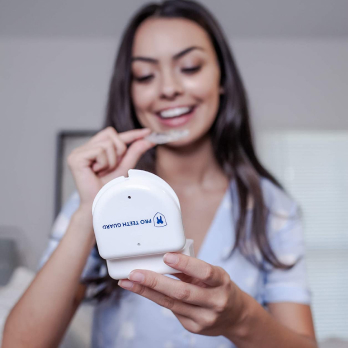Epilepsy and Teeth Grinding
6th Feb 2022
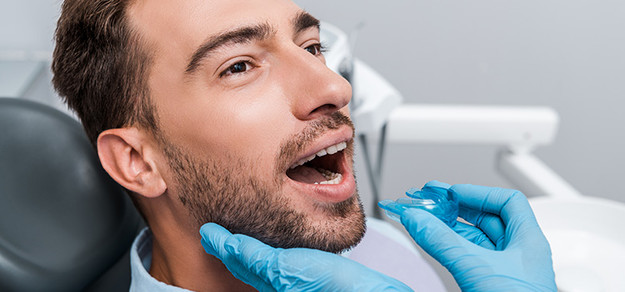
Epilepsy is a neurological condition that affects more than 3 million Americans. Genetic factors, brain injuries, tumors, and infections are possible causes of epilepsy. People with this condition experience periods of altered brain activity that can trigger seizures. Anxiety, loss of consciousness, stiff muscles, and rhythmic jerking are some of the symptoms that may occur when someone has a seizure. These side effects contribute to a link between epilepsy and teeth grinding.

Does Epilepsy Cause Bruxism (Teeth Grinding)?
Yes, teeth grinding is a fairly common occurrence in those who suffer from epileptic seizures. According to the American Family Physician, seizures occur when electrical activity in the brain increases as a result of involuntary, rhythmic movements and convulsions. If you see someone having a seizure, you might notice the person’s legs, arms, or jaw jerking repeatedly and their lips smacking together.
Additionally, Sound, Sleep, Health explains that those who suffer from epilepsy have “higher arousal events throughout the night”, making sleep bruxism more common. Epilepsy patients’ grinding habits have been studied using EEG (Electroencephalogram). Epileptic seizures also increase a person’s risk of related sleep disorders such as insomnia, obstructive sleep apnea, and parasomnias, including sleepwalking and night terrors. These types of parasomnias typically happen during non-rapid eye movement sleep (non-REM sleep), the first of the sleep stages. They may be caused by nocturnal seizures.
What Are the Signs and Symptoms of Bruxism in People With Epilepsy?
Patients with epilepsy have the same signs and symptoms of bruxism as individuals without epilepsy. People with bruxism may experience the following:
- Jaw, neck, or facial pain
- Chipped teeth
- Worn enamel
- Flattened teeth
- Dull headaches
- Fatigue or sleepiness from lack of sleep
- Jaw muscle soreness
If left untreated, these symptoms can progress to other conditions such as temporomandibular joint disorder, which may require extensive dental treatment.
Related Articles:
How Is Bruxism Diagnosed in Patients With Epilepsy?
Patients with epilepsy may be diagnosed with bruxism by their dentists or neurologists. The healthcare professional will examine the patient’s mouth and teeth to check for damage or signs of excessive wear.
They will look for indentations in the patient’s tongue, and they’ll also check for misalignment of the teeth. In addition, the clinician may feel the patient’s facial and jaw muscles to check for pain.
If you are unsure if your teeth grinding is a result of epilepsy or other causes, schedule an appointment with your neurologist.
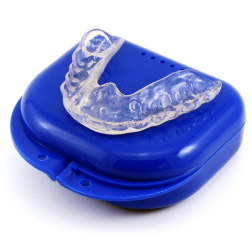
- Most Popular
- Hard Outside, Soft Inside
- 2MM Thick
- Moderate / Heavy
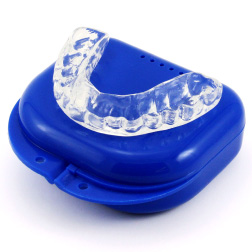
- Most Durable
- Hard Materials
- 1.5MM Thick
- Heavy / Severe
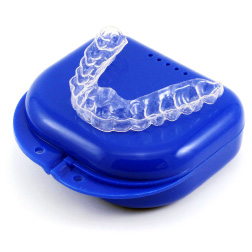
- For Day Time Use
- Thin, Barely Visible
- 1MM Thick
- Light / Moderate
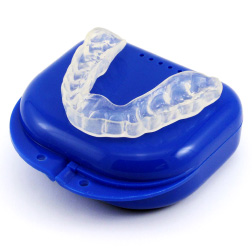
- For Clenching
- Flexible & Soft
- 1.5MM Thick
- Light / Moderate
How Is Bruxism Treated in Patients With Epilepsy?
For the most successful treatment, people with epilepsy and teeth grinding should have their neurologists and dentists involved in their bruxism care plans.
Mouthguards: Mouthguards and splints are the most common solution. These devices keep the teeth separated, and they’re worn on the upper or lower teeth. They can be made of soft materials or hard acrylic. When worn properly, they’ll reduce the tooth damage that’s caused by clenching and grinding.
Relaxation Techniques: Meditation, breathing exercises, biofeedback, and other relaxation techniques may be recommended to reduce the stress that might be triggering teeth grinding. The patient’s dentist or physical therapist might suggest jaw positioning exercises. The patient can practice these to reduce jaw tension and muscle contractions.
Medications: In some cases, medications might be prescribed to manage the painful symptoms of bruxism. Some people may find that taking bruxism muscle relaxants before bedtime helps. If stress is a major trigger for teeth grinding, patients could be offered prescriptions for antidepressants or anti-anxiety medicines. Speak to your dentist or doctor if you feel you need medication to manage your teeth grinding.
Botox: Botox injections may be considered for people with severe bruxism. The botox injected into the jaw muscles temporarily restricts movement, allowing the muscles to relax. Although more research is needed, Botox injections have helped some individuals who did not respond to other treatments.
Related Articles:

It’s vital to treat all associated conditions during bruxism treatment. Patients should continue to take all of their epilepsy medications. The Epilepsy Foundation offers many seizure and epilepsy treatment options. By reducing the patient’s risk for seizures, the epilepsy medicines could reduce the amount of teeth grinding that the patient experiences.
Patients should let their dentists and neurologists know right away if they notice any new, worsening, or concerning symptoms during treatment.
Prevalence of Bruxism in Patients with Epilepsy
While there has been a clear link established between epilepsy and bruxism, there are certain kinds of epilepsy that are more closely related to teeth grinding. Additionally, age plays a role in the prevalence of bruxism in epileptic patients as well.
According to case reports, bruxism seems to be more common in people with temporal lobe epilepsy. In fact, many orofacial movement disorders are often associated with temporal lobe epilepsy. While some patients with generalized seizures only grind their teeth at night, individuals with temporal lobe epilepsy might grind their teeth during the day, too.
Children and adolescents with epilepsy have up to 70% of their seizures at night. The prevalence of movement disorders such as sleep apnea, sleep walking, and night terrors is higher in children and adolescents with epilepsy than in adults with epilepsy.
What Should I Do if I Need Mouthguards for Bruxism?
While the etiology of bruxism requires further research, there is a clear link between epilepsy and teeth grinding that has been studied in sleep medicine. The jerking movements and anxiety that often accompany seizures can cause patients to grind and clench their teeth. It is important to address bruxism as soon as possible to avoid painful symptoms. Fortunately, there are many treatment options for bruxism, including custom fitted night guards.
If your healthcare professional has recommended mouthguards as part of your bruxism treatment, you may want to purchase yours from Pro Teeth Guard. We provide affordable, custom-fit mouthguards that you can buy online. Just like the mouthguards you’d get from your dentist, Pro Teeth Guard mouthguards are made in a professional dental lab with professional techniques and materials.
References:
- American Academy of Family Physicians. (2007). Seizures: What You Should Know. American Family Physician. https://www.aafp.org/afp/2007/0501/p1348.html
- Doshi, H., Kataria, M., Shah, A. K., & Zutshi, D. (2021). Bruxism: A Rare, Nonlateralizing Temporal Lobe Ictal Phenomenon. Neurology Clinical Practice. https://cp.neurology.org/content/11/5/e727
- Mayo Clinic Staff. (2017). Bruxism (Teeth Grinding): Diagnosis & Treatment. Mayo Clinic. https://www.mayoclinic.org/diseases-conditions/bruxism/diagnosis-treatment/drc-20356100
- Mayo Clinic Staff. (2017). Bruxism (Teeth Grinding): Symptoms & Causes. Mayo Clinic. https://www.mayoclinic.org/diseases-conditions/bruxism/symptoms-causes/syc-20356095
- Meletti, S., Cantalupo, G., Volpi, L., Rubboli, G., Magaudda, A., & Tassinari, C. A. (2004). Rhythmic Teeth Grinding Induced by Temporal Lobe Seizures. Neurology. https://n.neurology.org/content/62/12/2306
- National Center for Chronic Disease Prevention and Health Promotion, Division of Population Health. (2020). Epilepsy Data and Statistics. Centers for Disease Control and Prevention. https://www.cdc.gov/epilepsy/data/index.html
- Newsom, R. (2020). Epilepsy and Sleep: Challenges and Solutions. Sleep Foundation.. https://www.sleepfoundation.org/physical-health/epilepsy-and-sleep
- Pacheco, D. (2022). Parasomnias: Types, Symptoms, & Causes. Sleep Foundation. https://www.sleepfoundation.org/parasomnias
- Schachter, S. (2013). Treating Seuizres and Epilepsy. https://www.epilepsy.com/learn/treating-seizures-and-epilepsy
- Sound, Sleep, Health Staff. (2016). Epilepsy and sleep: The silent struggle with nighttime seizures. https://www.soundsleephealth.com/epilepsy-and-sleep-the-silent-struggle-with-nighttime-seizures/
- Taylor, M. (2015). Bruxism in the Neurology Clinic. Practical Neurology. https://practicalneurology.com/articles/2015-sept/bruxism-in-the-neurology-clinic

- Most Popular
- Hard Outside, Soft Inside
- 2MM Thick
- Moderate / Heavy

- Most Durable
- Hard Materials
- 1.5MM Thick
- Heavy / Severe

- For Day Time Use
- Thin, Barely Visible
- 1MM Thick
- Light / Moderate

- For Clenching
- Flexible & Soft
- 1.5MM Thick
- Light / Moderate

